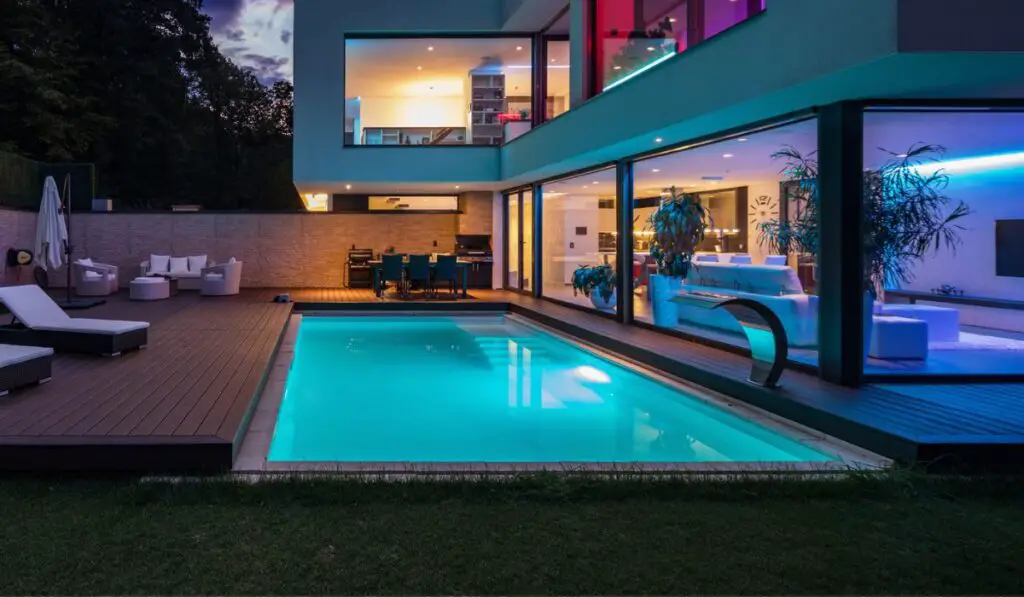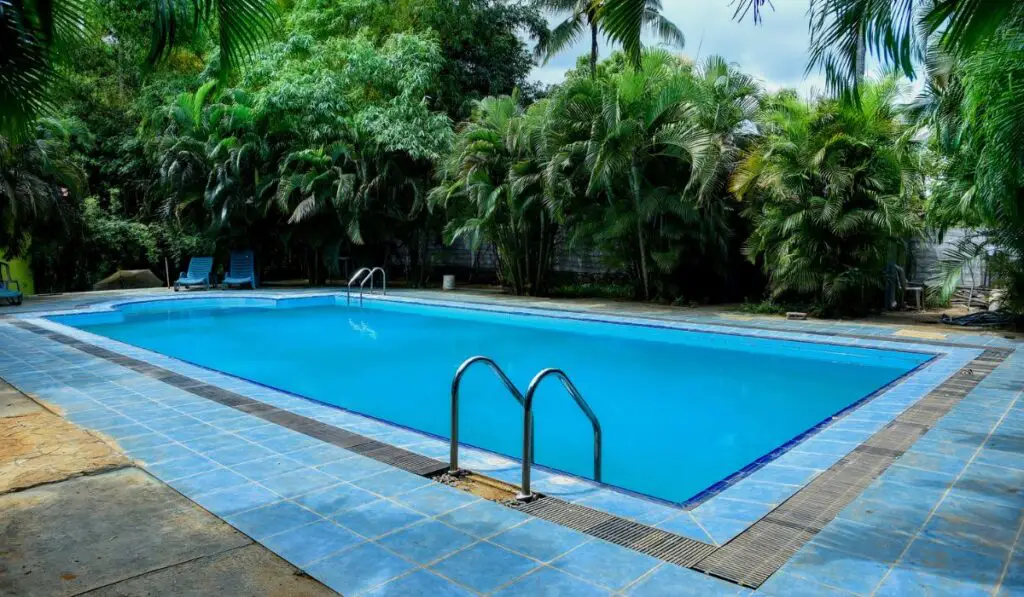Septic systems are notoriously sensitive, and there are a handful of things that can easily damage them. They’re also quite large and therefore take up a sizable part of any yard. For these reasons, household alterations that involve chemicals — particularly if it relates to plumbing — need to be done with great care. So what about a pool? Can you have one in the same yard as a septic system?
You can have a pool and a septic system in your yard, but the two need to be sufficiently distanced in order to avoid problems. Inground pools should be at least 25 feet from a septic tank, while above-ground pools can be 15 feet away. Make sure to consult an expert.
Let’s take a closer look at everything you need to know when it comes to having both a pool and a septic system on your property.
Why Would a Septic System Interfere With a Pool?

Are you wondering why a septic system might interfere with a pool in the first place? The main reason is simply the size of a septic tank, which is buried underground and can take up a large portion of your yard. A pool is also quite large, and it needs to be a fair distance away from the septic tank — so space can easily become a problem.
You also need to stay away from what’s known as the leach field area. This is where the soil can absorb excess water going to the septic tank.
If there’s also pool water to contend with, it could cause back-ups into the house. The last thing you want is to find that sewage is backing up into the bathroom.
How Close to a Septic Tank Can You Put a Pool?
The Public Health Code in your area will dictate the exact distance required between a pool and a septic tank, so make sure you review it before planning to build a pool. However, the distance for an inground pool is usually around 25 feet, and it shortens to around 15 feet for an above-ground pool.
If your yard is relatively small, that makes the above-ground pool a better option. There’s no getting around these requirements, and they will be checked by officials before you get permission to build a pool.
Can You Have an Above-Ground Pool With a Septic Tank?
Not only can you have an above-ground pool with a septic tank, but it’s often the better option. Although you still have to distance it from the septic tank and the leach field, it usually requires less distance to be considered safe, as we mentioned.
Above-ground pools are also less expensive to build and generally take less time to install, so those are other advantages to keep in mind.
Avoid the Leach Field
You might put so much work into avoiding the septic tank that you forget to avoid the leach field — and this not a mistake you want to make. It’s not just that it can cause back-ups, but the leach field actually has lines running through it.
If you dig into the ground to install an inground pool, you might hit one of these lines and puncture it. That’s a costly repair, and you’re already going to be spending a lot on the pool.
As for an above-ground pool, it’s still important to avoid the leach field due to drainage issues.
A good pool contractor will make sure to avoid the leach field and tell you exactly where you can place the pool.
Don’t Overflow the Leach Field
The leach field is specifically designed to get rid of water by filtering it down through the soil. If you keep adding water, it’s not going to be able to handle the amount — and that’s when you might start getting drainage issues.
Make sure not to push it too far. It’s not just that it’s a hassle for waste to back up into the house, but it can also be dangerous due to the amount of bacteria present in a septic tank.
Can You Have an Inground Pool With a Septic Tank?
Although it’s even more important to be careful with an inground pool than it is an above-ground pool, it’s still possible to have one with a septic tank. The main thing is just to make sure that the pool is far enough away and that it doesn’t impeach on the leach field.
This does mean you’ll need sufficient space in your yard, so those with smaller yards may not be able to fit an inground pool, unfortunately.
What Are the Physical Requirements to Consider?
Although the size of the yard is the main requirement, there are some other things to consider. You have to make sure your pool is within the property line and an appropriate distance from the fence or even just the edge of your yard.
A pool can’t extend beyond that point, and even water slopping over the edge may end up being a problem.
An expert will be able to advise you on what’s best for your property.
Will You Need Permits?
Many people believe that if they’re doing something in their own yard, they don’t need a permit.
The truth is, you do need permits for any building project. The authorities need to know the layout of the land so they can ensure the pool is the proper distance away from the septic tank and won’t interfere with anything else nearby.
How Do You Drain a Pool With a Septic Tank?
Another important thing to consider when installing a pool near a septic tank is how to drain it. Although most pool repairs and maintenance can be done without draining the water, there are times when you do need to drain the entire pool.
While most people can simply use a hose to drain the pool inside of the house, this isn’t possible if you have a septic tank.
You can’t drain your pool into the septic tank. Your pool has chemicals that may mess with the tank, there’s likely too much water for the septic tank to handle. You can either drain the water slowly into your lawn (if your yard is big enough to do so away from the septic tank) or ask for permission to drain into a sewer line in the street.
Before draining at all, you should dechlorinate the water. You can buy dechlorinator (on Amazon), and you should always test the chemical level before you decide it’s safe to go ahead and swim.
You can also just leave the water for a while and test it continuously, as sunlight will naturally get rid of the chlorine. It all depends on how quickly you need to get the process done.
You should also make sure you actually need to drain the water, as there are few situations where this is necessary, and it can be a bit of a hassle.
You should then get a submersible water pump (on Amazon) and attach a hose to the end of that, regardless of the draining method you use. Either drain the water in different spots around the yard slowly and allow the soil to soak it up, or drain it into that main sewer line after getting permission.
You should never, under any circumstances, drain the water straight into the street without attaching it to a sewer line. Not only can this flood the street but it can get you in a lot of trouble, as it’s illegal in most states.
It’s also important never to just leave the water draining into your yard with no consideration, as the grass and soil will eventually be too saturated, and the water may flow into other yards.
Can You Get Rid of a Septic Tank?
If the septic tank is getting in the way of a pool due to the size of your yard or the specific place you want the pool, you might be wondering if you can get rid of the septic tank altogether.
You can, but your property must be connected to a sewer line first, and then you’ll need specialists to get rid of the septic tank and all of the waste inside. This can add a lot to your budget, so you should only do this if you’re prepared to spend big.
Can You Have a Pool Near Main Line Sewers?

If you’re connected to the main sewer line rather than a septic tank, building a pool is a much simpler affair. There’s no need for the same distance that a septic tank requires.
It’s also possible to divert the lines if you need to, though you will need permission and skilled contractors to do this. You should also ensure you can afford it, as it’s likely to be an expensive process.
Overall, it’s perfectly possible to have either an inground or above-ground pool with a septic tank in your yard. That’s good news to those who are worried about it!
However, you do need to have the proper permits in place and a big enough yard to distance the pool either 15 or 25 feet from the tank, depending on the type of pool. You also need to take the proper precautions when draining it or you could cause a lot of problems.
